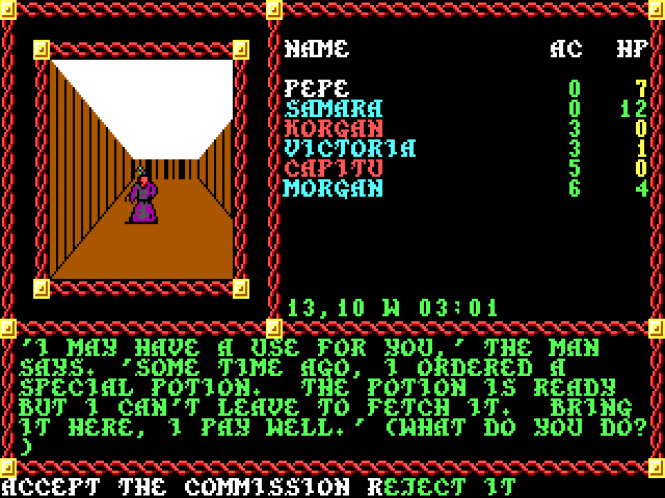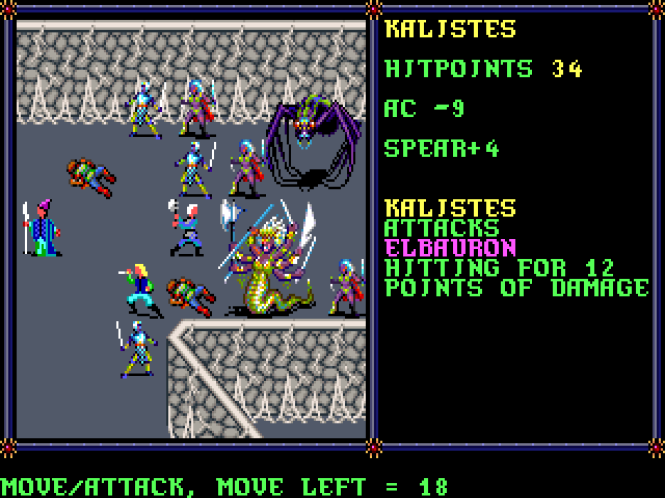Pool of Radiance would be the first in a series of four computer role-playing games set in the Forgotten Realms Moonsea region. It would also launch the acclaimed and influential “Gold Box” titles developed by SSI – so called due to the iconic golden boxes they were packaged in.
The first officially licensed Dungeons & Dragons computer game, it faithfully adapted the extremely popular AD&D pen and paper rules to the virtual environment for the first time, paving the way for many games to follow. A remarkable feat at the time, the game packed a meticulous implementation the expansive ruleset, from its spell book and combat mechanics to a statistically accurate bestiary. Even the monster portraits can be traced to AD&D’s 1st Edition Monster Manual, recreated in pixelated form. Other iconic mechanics adhered to include resting and the time needed to heal or memorize spells.
From the very start Pool of Radiance provides the basics of the role-playing genre, requiring players to create a party of up to six characters, built from AD&D’s multiple races and class combinations.

The heroes would then begin at the port city of Phlan, motivated by fortune or glory to win back the city from its monstrous overlord. A novel feature, Pool of Radiance is a mission-based adventure, with characters receiving assignments from the Council, or taking up tasks that are completely optional. The open nature of its structure allowed players to go about quests in any order, and most objectives could be accomplished through multiple solutions.
Exploration is done in first-person; with a 3D view port window into the fantastic world – similar to The Bard’s Tale series. The interface is clunky and slow, but individual character sheets display all the vital information one would expect from the tabletop game. Players must learn to track hit points, THAC0, armor class, inventories and spell books, contributing to the pervasive feel of pen and paper.

When diplomacy fails and a battle begins, the player is switched to a top-down “isometric” view of a field, derived from Wizard’s Crown. The characters are represented by icons (you can even customize yours), and movement and positioning is crucial. Staged against foes in tactical turn-based resolution, the game boasts some impressive large-scale battles, sometimes with dozens of enemies at once.
Also featured is the overland map. Upon leaving the city or one of the many dungeons in the outskirts, the party is changed to representation by a single icon in order to traverse the open land. This includes the possibility of random encounters, discovering new locations or other hidden secrets.

After finishing Pool of Radiance, players may transfer their heroes to the next game in the series, all the way to the fourth game. Characters can progress in a sweeping campaign, similar to ongoing play in pen and paper, reaching epic power levels.
The sequel, Curse of the Azure Bonds (1989), was a more story-focused adventure, the party awakening to find their equipment stolen (a cheap balance trick) and their arms branded with mystic blue sigils, which rob them of their free-will. The characters would then follow the footsteps of Alias and Finder Wyvernspur, as told in the TSR published novel Azure Bonds.

The game expanded upon the Gold Box engine, introducing the Paladin and Ranger classes and adding a “fix” command to facilitate the healing process in the camp menu. The overland map now included small utility towns, which offered temple, tavern and shop services from only a menu. Also included were mini-dungeons for the party to explore, as a bonus content loosely tied to the main storyline.
The third title of the saga, Secret of the Silver Blades (1990), sends the party to an entirely different region, the mining town of New Verdigris – although events still tie in to a wider tapestry being weaved. Gone was the overland map portion of adventure, replaced by confinement around the mysterious Well of Knowledge, using teleporters to access areas.

Unfortunately, Secret of the Silver Blade might be considered not only the weakest of the series, but perhaps of all the Gold Box games. Its plot is simple and linear, with few role-playing opportunities and far too many random encounters, which can get tiresome.
Finally, in 1991, SSI released the culminating title Pools of Darkness, delivering an epic conclusion in the truest sense of the word. The characters would level up to dizzy heights advancing to forty, and be thrown against the very pawns of a vengeful god.

The overland map was back – but multiplied –, taking the party to different dimensions. Supremely memorable was the section taking place in the spider realm of the marilith Kalistes, which should strike a chord with any AD&D fan who played the Queen of the Demon Web Pits module. And there was still a high level post-game dungeon, designed by Dave Shelley.
A massive commercial and critical success, the Pool of Radiance games were remarkable not only for bringing an authentic Dungeons &Dragons experience to computers, but also for allowing players to forge a heroic story across four expertly crafted titles. Dorateen


See also early MMORPG sequel NWN Neverwinter Nights on AOL from 1991 – 1997 ++
* https://en.wikipedia.org/wiki/Neverwinter_Nights_(1991_video_game)
* http://www.bladekeep.com/nwn/index2.htm
LikeLike